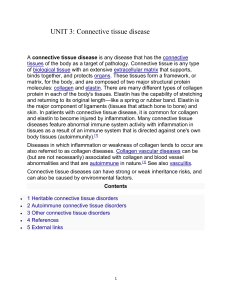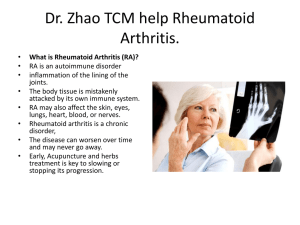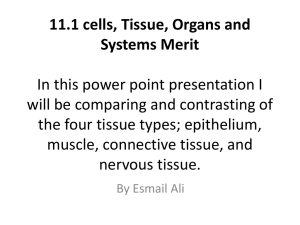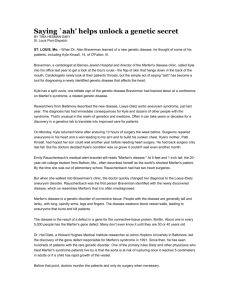Connective Tissue Disorders
advertisement
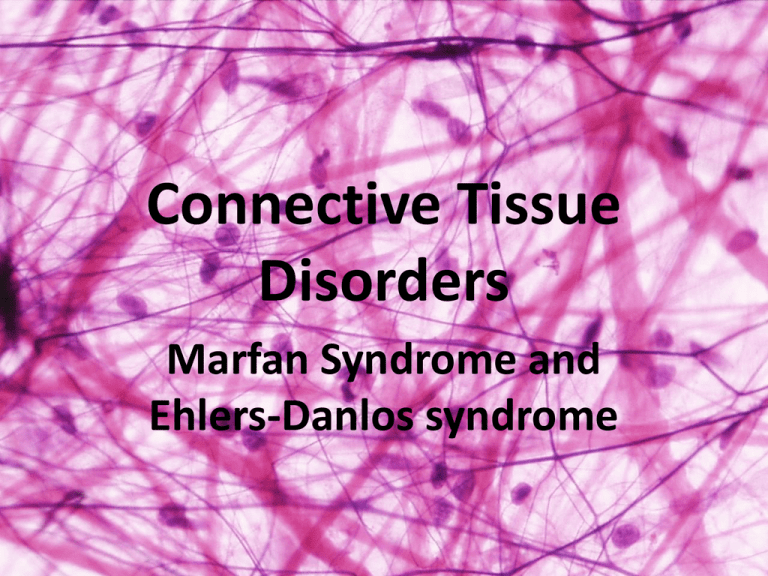
Connective Tissue Disorders Marfan Syndrome and Ehlers-Danlos syndrome • The connective tissues are the structural portions of our body that essentially hold the cells of the body together. • These tissues form a framework or matrix for the body. • The connective tissues are composed of two major structural molecules, collagen and elastin. • There are many different collagen proteins that vary in amount in each tissue of the body. • Elastin is another protein that has the capability of stretching and returning to original length like a spring. – Elastin is the major component of ligaments (tissues which attach bone to bone). • Diseases of connective tissue that are strictly inheritable include: – Marfan syndrome – Ehlers-Danlos syndrome • The classic immune-related connective tissue diseases include diseases such as rheumatoid arthritis, which the cause is unknown, but hypothesized to be due to bacteria or fungi • Individuals with undifferentiated connective tissue disease may never develop a fully definable condition or they may eventually develop a classic connective tissue disease. Mixed connective tissue disease is an "overlap" combination of connective tissue diseases • The course of the disease is chronic and usually milder than other CTDs. • Diagnosis of mixed connective tissue disease is supported by detecting abnormal antibodies in the blood. • Treatment of mixed connective tissue disease is directed at suppressing immune-related inflammation of tissues. Marfan • Skeleton - People with Marfan syndrome are typically very tall, slender, and loose-jointed. – Arms, legs, fingers, and toes may be disproportionately long in relation to the rest of the body. – Long, narrow face • Eyes - More than half of all people with Marfan syndrome experience dislocation of one or both lenses of the eye. – Many people with Marfan syndrome are also nearsighted, may develop glaucoma or cataracts • Heart and blood vessels (cardiovascular system) - Most people with Marfan syndrome have problems associated with the heart and blood vessels. Because of faulty connective tissue, the wall of the aorta (the large artery that carries blood from the heart to the rest of the body) may be weakened and stretch, a process called aortic dilatation. • Nervous system - The brain and spinal cord are surrounded by fluid contained by a membrane called the dura, which is composed of connective tissue. As someone with Marfan syndrome gets older, the dura often weakens and stretches, then begins to weigh on the vertebrae in the lower spine and wear away the bone surrounding the spinal cord. • Skin - Many people with Marfan syndrome develop stretch marks on their skin, even without any weight change. These stretch marks can occur at any age and pose no health risk. However, people with Marfan syndrome are also at increased risk for developing an abdominal or inguinal hernia, in which a bulge develops that contains part of the intestines. • Lungs - Although connective tissue problems make the tiny air sacs within the lungs less elastic, people with Marfan syndrome generally do not experience noticeable problems with their lungs. – Snoring or sleep apnea possible People with Marfan's are typically tall, with long limbs and long thin fingers. Phelps stands 6'4", and has an armspan of 6'7", which is greater than his height. That is a ratio of 1.04, which is just shy of the clinical cutoff of 1.05. • He is also said to have hypermobile joints in his knees, shoulders and ankles. Ehlers-Danlos syndrome • Ehlers-Danlos syndromes are a group of disorders which share common features including easy bruising, joint hypermobility (loose joints), skin that stretches easily (skin hyperelasticity or laxity), and weakness of tissues. • The fragile skin and loose joints is often a result of abnormal genes that produce abnormal proteins that confer an inherited frailty of collagen (the normal protein "glue" of our tissues). • In 2001, researchers discovered a new form of Ehlers-Danlos syndrome that is caused by an inherited abnormality in a protein other than collagen that also normally plays a role in binding together the cells of our tissues (including the skin, tendons, muscle, and blood vessels). • Abnormalities in this protein, called tenascin, also lead to a form of Ehlers-Danlos syndrome. Researchers suspect that tenascin could play a role in regulating the normal distribution of collagen in the connective tissues of the body. Arthritis • Another form of connective tissue is fibrous connective tissue which is found in tendons and ligaments. • Rheumatoid arthritis – Rheumatoid arthritis is a systemic disorder in which immune cells attack and inflame the membrane around joints. It also can affect the heart, lungs, and eyes. Of the estimated 2.1 million Americans with rheumatoid arthritis, approximately 1.5 million (71 percent) are women • A joint is where two bones meet to allow movement of body parts. • Arthritis means joint inflammation. • The joint inflammation of rheumatoid arthritis causes swelling, pain, stiffness, and redness in the joints. • In some patients with rheumatoid arthritis, chronic inflammation leads to the destruction of the cartilage, bone, and ligaments, causing deformity of the joints. • The symptoms of rheumatoid arthritis come and go, depending on the degree of tissue inflammation. • When body tissues are inflamed, the disease is active. When tissue inflammation subsides, the disease is inactive (in remission). • Remissions can occur spontaneously or with treatment and can last weeks, months, or years – The course of rheumatoid arthritis varies from patient to patient, and periods of flares and remissions are typical. Stem Cells • Stem cells have the remarkable potential to develop into many different cell types in the body during early life and growth. In addition, in many tissues they serve as a sort of internal repair system, dividing essentially without limit to replenish other cells as long as the person or animal is still alive. • When a stem cell divides, each new cell has the potential either to remain a stem cell or become another type of cell with a more specialized function, such as a muscle cell, a red blood cell, or a brain cell.


